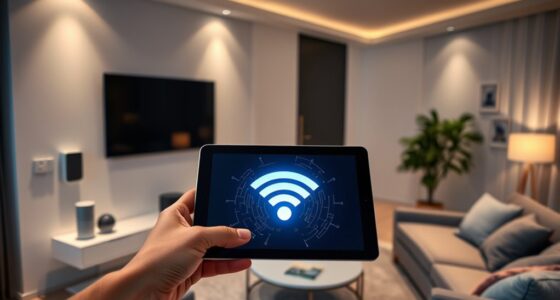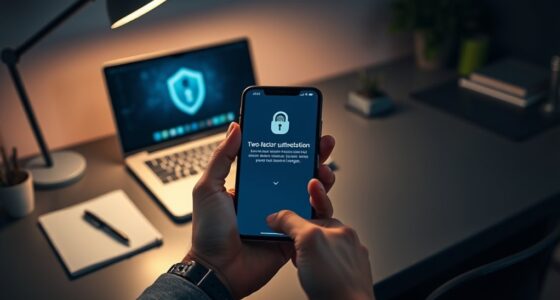Geo-fencing in smart homes can create convenience but also introduces vulnerabilities if someone uses location spoofing or signal jamming. Hackers can manipulate your device’s perceived location to disable alarms, release doors, or bypass security. These exploits highlight weak points in relying solely on location data. To protect yourself, you’ll want to learn more about safeguarding your devices and stay informed about how these vulnerabilities can be exploited.
Key Takeaways
- Attackers can spoof location data to disable security systems or unlock smart locks unexpectedly.
- Signal jamming and interference can cause false device triggers or disable geo-fencing protections.
- Manipulating GPS or Wi-Fi signals allows unauthorized access by deceiving the home’s location-based triggers.
- Weak security and outdated firmware increase vulnerability to location-based exploits.
- Enhanced security measures like encryption and multi-factor authentication are essential to prevent geo-fencing breaches.
Understanding Geo-Fencing in Smart Home Systems

Geo-fencing in smart home systems creates virtual boundaries based on your location, allowing your devices to respond automatically. When you enter or exit these virtual boundaries, your smart devices can turn on lights, adjust thermostats, or *disarm* doors. This technology relies on GPS, Wi-Fi, or Bluetooth signals to determine your position. However, savvy users can use location spoofing to deceive the system into thinking they’re somewhere else. By mimicking your device’s location, attackers can trigger or disable routines, potentially gaining unauthorized access or disrupting your home’s automation. Understanding how geo-fencing works helps you recognize its strengths and vulnerabilities. Ensuring your system’s security involves awareness of how virtual boundaries can be manipulated through techniques like location spoofing. Staying informed about current news in Indonesia can also help users be aware of broader technological security issues affecting daily life.
Common Vulnerabilities and Exploits

Despite its convenience, geo-fencing in smart home systems can be vulnerable to several exploits that compromise your security. One common vulnerability is device spoofing, where an attacker tricks the system into believing your device is elsewhere, granting unauthorized access or control. Signal jamming is another threat, where an attacker disrupts the communication between your device and the system, preventing accurate location detection. This interference can cause the system to misinterpret your presence, potentially *disarm* doors or disable security features at the wrong times. These exploits highlight how attackers can manipulate location data, bypassing safeguards meant to protect your home. Recognizing these vulnerabilities helps you understand the risks and emphasizes the importance of implementing additional security measures to prevent exploitation. Additionally, understanding the vetted Halloween product reviews can help families choose secure costumes that do not interfere with device sensors or communication systems.
Real-World Incidents of Location-Based Breaches

Real-world incidents have shown how vulnerabilities in location-based systems can lead to serious security breaches. One common method attackers use is location spoofing, where they manipulate GPS signals to deceive smart home devices into believing they are elsewhere. This allows them to trigger geo-fenced actions or disable security features, granting unauthorized access. For example, hackers have exploited poorly secured geo-fencing systems to unlock doors or disable alarms when the owner isn’t home. In some cases, attackers have used fake location data to bypass security protocols, gaining control over smart locks or surveillance cameras. These breaches highlight how easily location spoofing can be weaponized, putting your home’s security at risk if proper safeguards aren’t in place. Additionally, understanding high refresh rates and other display technology factors can help in designing more secure and resilient systems that detect anomalies in location data.
Best Practices for Securing Your Geo-Fencing Devices

To effectively protect your geo-fencing devices from malicious attacks, you need to implement strong security measures that prevent location spoofing and unauthorized access. First, keep your device firmware and apps updated to patch vulnerabilities. Second, enable multi-factor authentication to add an extra layer of security. Third, educate yourself about privacy concerns and stay aware of potential threats through user awareness programs. Visualize your security setup as a fortress:
- A digital barrier that blocks hackers from hacking into your location data
- Regularly changing passwords that confuse cybercriminals
- Clear privacy settings that limit data sharing and prevent unauthorized tracking
- Incorporate expert voice actors into your security messaging to enhance credibility and engagement.
Future Trends and How to Stay Protected

As technology advances, geo-fencing devices are becoming more integrated with smart systems and IoT networks, which opens new security challenges. Future trends include stronger encryption, AI-driven anomaly detection, and user-controlled privacy settings. However, these developments raise privacy concerns and ethical implications, especially regarding data sharing and surveillance. To stay protected, you should keep firmware updated, use multi-factor authentication, and carefully review device permissions. Educate yourself on data collection practices and opt for devices that prioritize user privacy. The table below highlights key future trends and protective measures:
| Future Trends | How to Stay Protected |
|---|---|
| Advanced AI security algorithms | Regularly update firmware and software |
| Increased privacy controls by users | Limit data sharing and permissions |
| Ethical considerations in data use | Stay informed on privacy policies |
Frequently Asked Questions
How Do Hackers Bypass Geo-Fencing Security Measures?
Hackers bypass geo-fencing security measures through location spoofing, where they fake GPS signals to appear elsewhere, and signal jamming, which disrupts the device’s ability to receive accurate location data. By manipulating these signals, they can trick your smart home system into thinking you’re in a different location or prevent it from detecting your presence altogether. Staying aware of these tactics helps you better protect your devices from such vulnerabilities.
Can Geo-Fencing Data Be Hacked Remotely?
Is your smart home privacy truly secure? Think of geo-fencing data as a fragile thread easily broken by hackers. Yes, it can be hacked remotely through location spoofing, allowing intruders to manipulate your device’s geolocation. They exploit vulnerabilities in the system, bypassing safeguards and gaining access. Stay vigilant, update your security, and be aware that even your location data isn’t immune to remote threats.
What Are the Signs of a Geo-Fencing Breach?
If you suspect a geo-fencing breach, watch for unusual activity on your smart home devices, like false alerts or unexpected device behavior. Privacy concerns may arise if your device reports location data inaccurately or shows signs of location spoofing. You might also notice discrepancies between your actual location and what the system thinks. Staying vigilant helps you catch these signs early and protect your smart home from potential vulnerabilities.
Are There Legal Consequences for Geo-Fencing Vulnerabilities?
Imagine a homeowner facing a geo-fencing breach that exposes their location data without consent. You should know that legal liabilities can arise if privacy concerns are ignored or mishandled. Laws vary by jurisdiction, but companies or individuals neglecting security measures may face lawsuits or regulatory penalties. These legal consequences highlight the importance of securing geo-fencing systems to protect privacy and prevent costly legal actions.
How Often Should I Update My Smart Home Security Protocols?
You should update your security protocol regularly, ideally every few months, to stay ahead of potential threats. The update frequency depends on recent security developments and your smart home devices’ firmware updates. Stay vigilant and check for updates often, especially after any security breach or vulnerability report. Consistent updates help patch vulnerabilities, strengthen your defenses, and guarantee your smart home remains protected against evolving risks.
Conclusion
As you navigate the smart home landscape, remember that even small oversights can lead to big security breaches. Coincidentally, many vulnerabilities stem from seemingly minor misconfigurations or outdated devices—reminding you to stay vigilant. By understanding geo-fencing risks and adopting best practices, you can protect your home and peace of mind. After all, in a world where technology and trust intersect, staying informed is your best defense against unexpected vulnerabilities.









